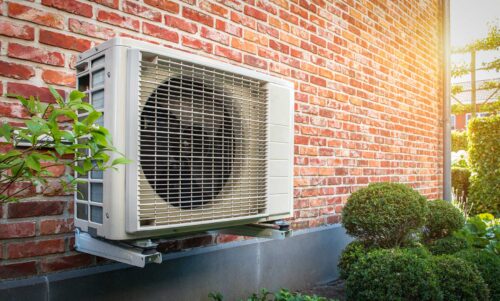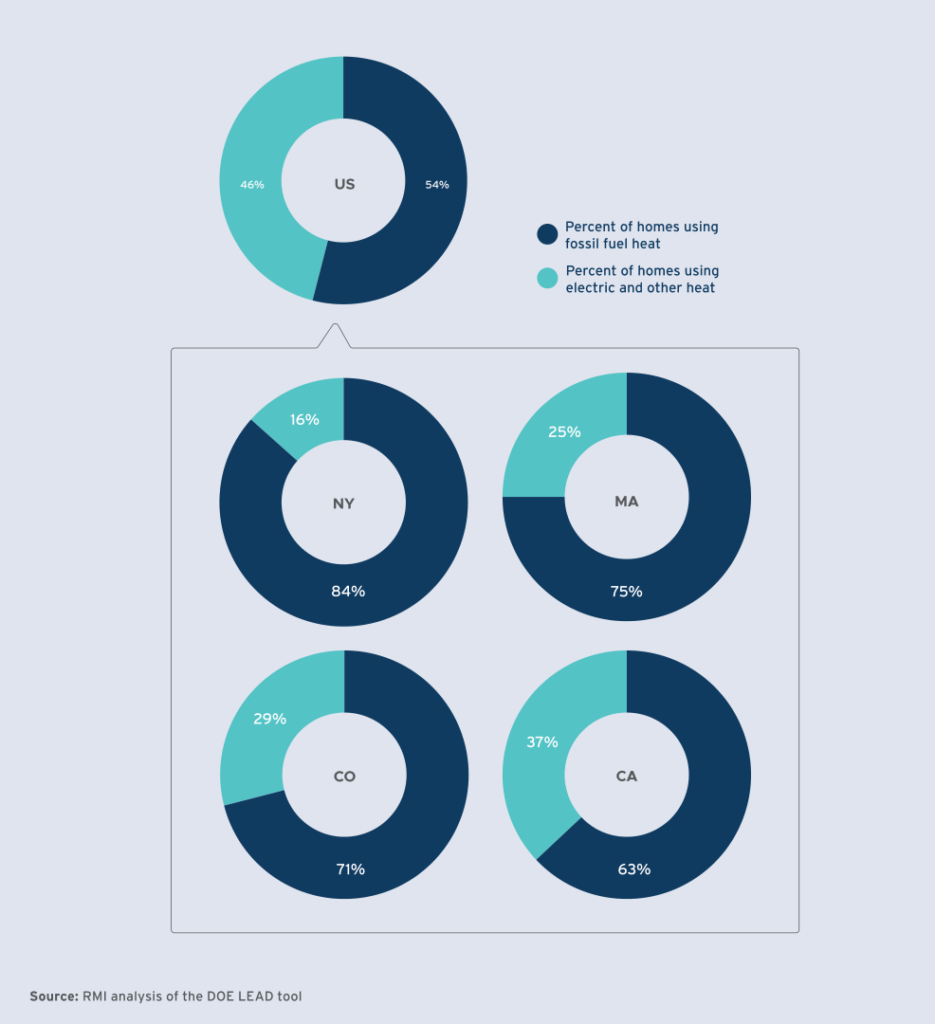
Now Is the Time to Go All In on Heat Pumps
A new RMI analysis shows that in all 48 continental states, replacing a gas furnace with a heat pump could reduce climate pollution by up to 93 percent.
Replacing fossil fuel-burning appliances with high-performing electric alternatives is crucial to meet our climate, health, and economic goals. However, the most recent data shows the United States is still not making significant progress, with emissions from buildings staying flat for decades. Altogether, in 2021, the use of gas or fuel oil for heating, hot water, and cooking accounted for more than 10 percent of US carbon emissions.
As federal incentives from the 2022 climate bill, the Inflation Reduction Act, begin to roll out, more Americans than ever before will be able to electrify different parts of their lives, from transportation to home heating. For this article, we’re focusing on one of the more efficient clean heating and cooling appliances — the air-source heat pump, which delivers two to four times more heating energy than the electricity it consumes.
And heat pumps are having their moment in the spotlight. Previously primarily used in warmer climates, heat pumps outsold gas furnaces for the first time last year and colder states like Maine are leading the way in home installations.
But skeptics wonder, can a heat pump really reduce a building’s emissions over its lifetime, even in the coldest of climates? And can they reduce them on year one, even if a utility is still using primarily fossil fuels like coal, gas, and oil for electricity?
To answer these questions, RMI released an updated analysis that examines the lower 48 states, focusing on the two largest direct uses of fossil fuel in buildings: space heating and water heating. We compared gas furnaces and gas water heaters to readily available electric alternatives: air-source heat pumps and heat pump water heaters. Grid emissions intensities were drawn from NREL’s 2022 Cambium data sets, third annual edition. This analysis uses the mid-case scenario, which includes currently enacted state and federal policies, including major electricity sector provisions from the Inflation Reduction Act of 2022, and central estimates of technology cost reductions.
The results point to significant emissions reductions for space heating. In all 48 continental states, replacing a gas furnace with a heat pump will reduce emissions within the very first year of installation and across the 15-year lifespan of the product. In states across the country, from Florida to Michigan to California, heat pumps reduce emissions across their lifetime by up to 93 percent compared with gas furnaces. The emissions benefits of air-source heat pumps arise from the high efficiency of the equipment and reductions in the carbon intensity of electricity over time as more renewables come onto the grid.
Heat Pumps Are an Efficiency Measure
Heat pump technology has improved significantly in recent years. Even accounting for reduced efficiency in extreme cold weather, our analysis finds that modern air-source heat pumps are more than twice as efficient as gas furnaces. We calculated the operational year-round heat pump efficiency for the most populous city in each state by combining historical hourly weather conditions against the performance of modern, readily available heat pumps. Our analysis adjusted heat pump efficiency to account for backup electric resistance heat when and where it is needed — rarely, and during very cold days. For instance, in Fargo, North Dakota, where temperatures occasionally fall below -20°F in the winter, backup heating is needed for approximately eleven percent of the annual heating load.
The chart below shows the expected heat pump coefficient of performance (COP), which is a weighted average of the daily heat pump efficiency by heating degree days. A COP of 1 means the system is 100 percent efficient — heating energy is equivalent to electricity inputs. A COP of 2 means that for every kWh of electricity a heat pump consumes, it delivers 2 kWh equivalent of heat.
Heat pumps ranged from 2.2 to 4.5 times more efficient than an EPA ENERGY STAR gas furnace on an annual basis, and in no climate was a heat pump less than 200 percent efficient (COP of 2). Efficiency was highest in places with mild winters, like California, Tennessee, and Arizona. However, heat pumps were also more energy efficient than gas furnaces in cold climates like Colorado, Minnesota, and Wisconsin. This analysis did not account for ground-source or geothermal heat pumps. Separate RMI analysis indicates that such systems can achieve COPs of up to 5 with higher emissions reductions than air-source heat pumps.
Cold Climate Heat Pump Technology Keeps Getting Better
Heat pump performance will only continue to improve. Consider inverter-driven variable speed compressors. Inverter-driven variable speed heat pumps increase compressor speed to improve heating capacity as the outdoor temperature drops. Field tests carried out by the Electric Power Field Institute found that variable speed heat pumps were able to meet 100 percent of home heating needs in 0°F conditions.
The Department of Energy has launched the successful Cold Climate Heat Pump Challenge. The Challenge, initiated in 2021, is a multi-stakeholder effort to develop and deploy next-generation cold-climate heat pumps. A breakthrough came in 2022, with the announcement of a next-generation heat pump from producer Lennox. The prototype delivers 100 percent heating at 5°F and 70–80 percent heating at –10°F. The prototype will be validated with deployment and commercialization aiming for 2024. Additional prototypes from other manufacturers are showing similarly impressive results, including the Mitsubishi hyper heat units that are rated at 80 percent heating at –13°F.
While heat pump performance will only continue to improve, gas furnace performance is limited by the laws of physics. Standard gas furnaces are typically sold at around 80-90 percent efficiency, with high-efficiency models reaching up to 99 percent. Thermodynamically, no direct combustion furnace can achieve greater than 100 percent efficiency at converting fuel (natural gas) into heat. As explained in Clean Energy 101: Heat Pumps, heat pumps differ in that they simply move heat rather than creating it, allowing them to reach far greater levels of efficiency.
A Greening Grid Means More Emissions Savings
The emissions associated with operating a heat pump are determined by the emissions from generating electricity. No matter the efficiency of the heat pump, if the electricity used to power it comes from emissions-intensive sources such as coal, there will be high associated emissions.
Fortunately, the grid has become cleaner over time. The charts below represent the emissions intensity of the electricity grid in 2016 and in 2021.
The states where grid emissions did not significantly improve are in the Pacific Northwest (states that already have the lowest emissions intensity in the country). There, significant power capacity is derived from hydroelectric power generation, a carbon-free source of electricity. Two states with some of the highest improvements in emissions intensity are Utah and Wyoming. Notably, these states were the only two in the prior analysis where a heat pump for space heating would not have reduced emissions compared with a gas furnace. Nationwide and state-level policies, such as HB 411 in Utah, are driving emissions reductions in our electricity grid and improving the outlook of heat pumps for space heating.
The outcome for gas furnaces is different. For a gas furnace, the emissions will always be roughly a pound of carbon dioxide gas for every 10 cubic feet of gas burned, every year, for as long as you use the furnace. As a result, heat pump emissions have improved since the last time this analysis was performed while gas emissions stay stagnant.
The Story Doesn’t End with Space Heating
Water heating is a common application of natural gas combustion in homes. Fortunately, heat pumps and their efficiency and emissions benefits extend to the ability to heat water. Our analysis shows that replacing gas water heaters with heat pump water heaters will reduce emissions in every state over the lifetime of the equipment.
These results send a powerful message: installing an air-source heat pump or a heat pump water heater TODAY instead of a fossil fuel alternative, cuts carbon emissions in ALL states — on day one — and over the lifetime of the appliances.
The Heat Pump Revolution Must Prioritize Equity
As heat pumps are deployed as the system of choice for sustainable home comfort, decision makers must ensure that low-income populations are not left behind. Currently, low-income households heat using fossil fuels at a higher proportion than the national average.

In addition to the emissions benefits associated with heat pumps, the transition away from fossil fuel heating has positive health and environmental impacts that are particularly important for improving health disparities of overburdened and underserved communities and communities of color. For more, read our article on Investing in Healthier Low-Income Housing.
Heat pumps can also reduce a household’s energy burden — the percentage of income spent on energy costs. Most low-income populations spend a higher proportion of their income on energy bills than higher income populations.
For homes that rely on fuel oil, propane, or kerosene, space heating using heat pumps can amount to significant bill savings, thanks to the efficiency benefits discussed above. As such, heat pumps can be a powerful mechanism for reducing heating costs for burdened populations. Beneficial electrification —which combines high-performing all-electric appliances and equipment, a high-performance building envelope, enhanced ventilation, and better building energy management — can deliver the most health benefits to our underserved and overburdened communities.
Thanks to the passage of new laws, including the Bipartisan Infrastructure Law and Inflation Reduction Act, several programs designed to address energy poverty will receive an infusion of funds. Decision makers must prioritize the rapid deployment of heat pumps with intentional, comprehensive solutions driven by underserved and overburdened communities. Policymakers at the state, local, and federal levels can now take bold action to build a more equitable housing sector while working toward a zero-carbon, healthy future that benefits all.
The Path Ahead
For cities and states looking to take climate action, reduce inequities, and spur economic activity, the search is on for scalable, cost-effective, and high-impact solutions. Building electrification presents such an opportunity. More than 100 cities have passed legislation mandating or incentivizing all-electric new construction since July 2019. Numerous cities and states are exploring a transition for existing buildings, often phasing in all-electric appliances as gas appliances reach their end of life.
RMI is engaged with city and state officials across the country to chart a path that meets our climate goals, is economically attractive and attainable, and is beneficial for frontline communities and labor. And while the prevailing winds of power sector decarbonization should carry forward and be accelerated, for 100 percent of US homes, there is no need to wait for a cleaner grid to install a heat pump.
State policymakers and utilities should prioritize incentives that enable homeowners and landlords to electrify residential space and water heating with heat pumps that can stack with IRA incentives. While a handful of states like Maine and Vermont are already accelerating heat pump adoption, the advanced state of heat pump technology coupled with decarbonization of the electrical grid makes heating with residential heat pumps a valuable tool for climate action for nearly every state today.
To see the data used for the analysis, click here.